Welcome to MythBusters, a Golf Digest+ series where we explore answers to some of golf’s most common questions through a series of tests with golfers and robots. Sometimes definitive, other times less so, our findings aim to shed new light on topics that have consumed golfers for years.
How does moisture on a golf ball affect its flight, if at all? It might seem like an obscure question reserved for tour players, who will make adjustments based on the one or two yards of difference that moisture could cause. The rest of us aren’t good enough to care, we might think.
But what if the effects of a wet golf ball are far more significant than a few yards? If so, knowing how a wet golf ball flies differently than a dry one could be a simple way to save a few shots in soggy conditions.
We tested it.
More Golf Digest MythBusters 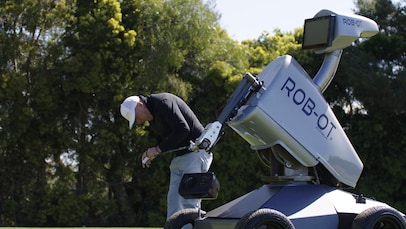 Golf Digest Logo How we use a robot golfer to better understand the human golfer
Golf Digest Logo How we use a robot golfer to better understand the human golfer 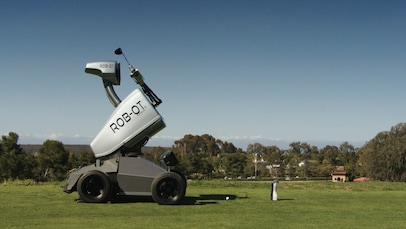 Golf Digest Logo Will you hit it farther by swinging faster or by swinging better? What our robot test reveals
Golf Digest Logo Will you hit it farther by swinging faster or by swinging better? What our robot test reveals 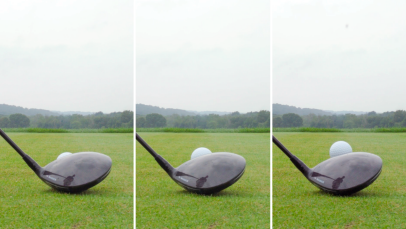 Golf Digest Logo Does a higher tee really produce more distance? What our test reveals Our test
Golf Digest Logo Does a higher tee really produce more distance? What our test reveals Our test
To measure how differently a wet golf ball flies compared to a dry one, we used the Golf Laboratories swing robot to hit a series of shots with a driver and a 5-iron with wet and dry golf balls. We used brand new premium golf balls.
With the help of Golf Labs founder and Golf Digest contributor Gene Parente, we used a 10.5 degree driver and 95 mile-per-hour swing speed—around the average for a male golfer. The robot hit six shots with a dry golf ball, followed by six shots with a golf ball that we sprayed three times with a water bottle on the tee prior to being struck.
For both the wet and dry balls, we tested six straight shots each before opening the clubface on the robot to simulate a 20-yard fade and closing the clubface to simulate a 20-yard draw. We hit six shots each with a wet and dry ball for each ball flight.
We repeated the same method with a 5-iron with an 85 mph swing speed.
We measured the swing and ball-flight data with Foresight Sports’ QuadMAX launch monitor. For the purposes of this test, we are focusing on four data points: total distance, dispersion, spin and height.
What we found
We’ll start with the driver results. As you can see in the table below, we found that with each swing type (straight, fade, draw), the wet golf ball travelled significantly shorter. With a straight shot, the wet ball traveled 15 yards less then dry one (227.1 yds. vs. 242.5 yds.). The wet ball lost about 14 yards of distance when hitting a fade, and it lost over 17 yards of distance when hitting a draw.
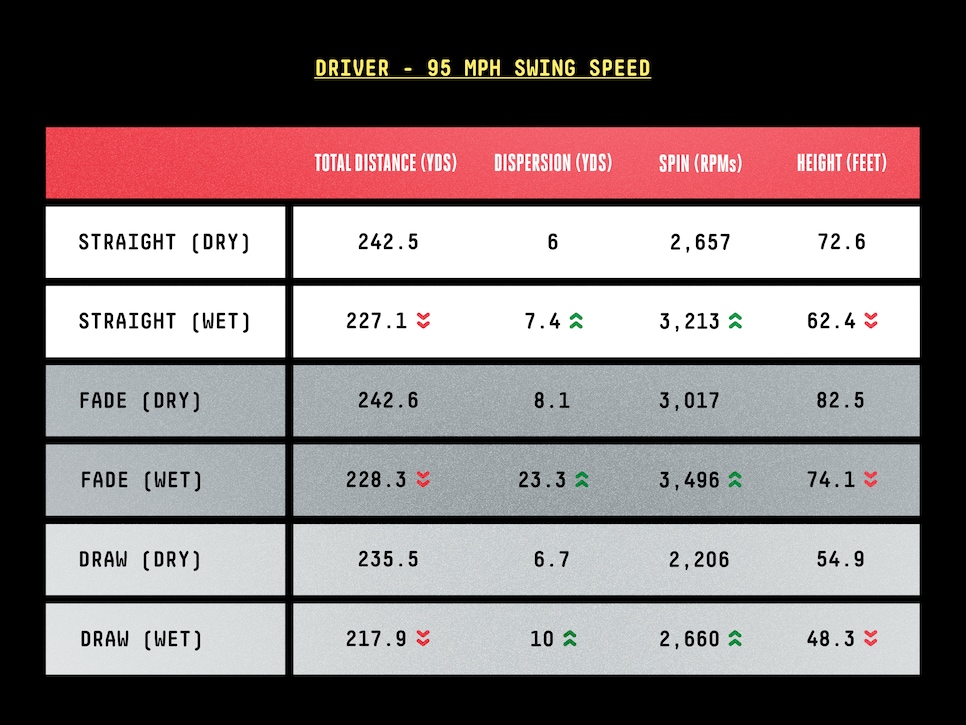
With each shot type, the average dispersion (how far the ball traveled off-line) was greater for the wet balls as well. For example, when hitting a fade, the wet ball averaged 23.3 yards off-line, vs. just 8.1 yards with the dry ball.
The moisture also produced increased spin and a lower ball flight with each shot type.
OK, now the 5-iron results, which were quite different. While wet golf balls with a driver travel shorter due to increased spin and a lower height, the moisture produce increased distance with a 5-iron on straight shots and fades.
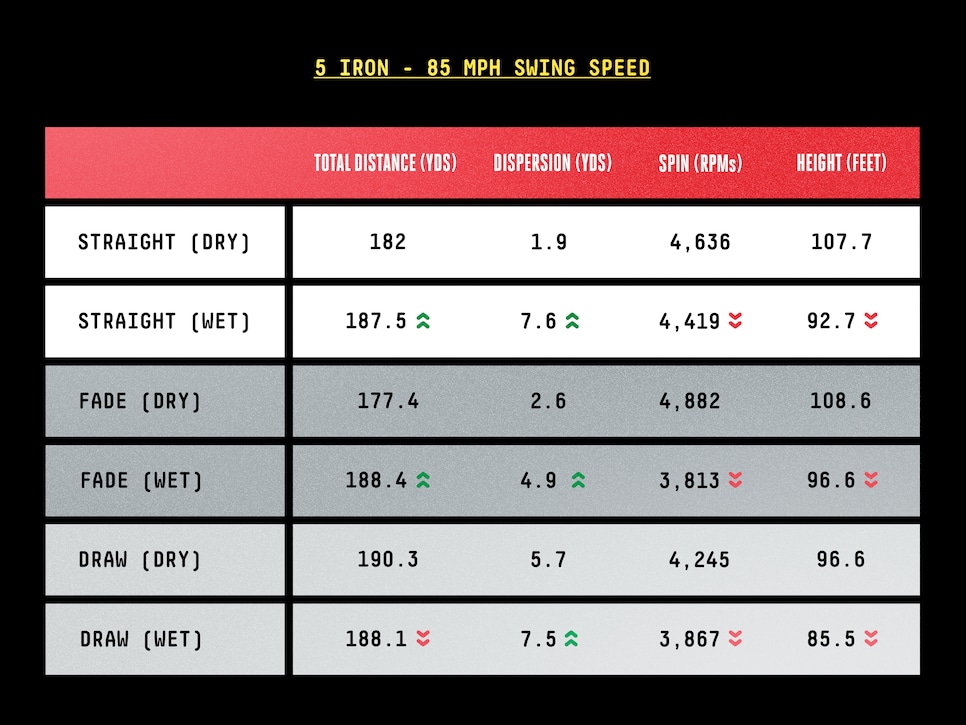
As you can see in the table, the wet golf ball with a straight ball flight traveled over five yards farther than the dry one (187.5 yds. vs. 182 yds.). This is in part due to the wet ball having less spin, which makes the ball travel a bit like it does out of a flier lie from the rough: lower and hotter.
Similar results were found when the robot hit a fade, but interestingly, the wet ball traveled shorter than the dry one when hitting a draw. This is due to a very low ball flight of 85.5 feet with the wet ball when hitting a draw, versus the nearly 100-foot apex with the dry ball.
Equally interesting are the dispersion data, which show that with each shot type, the wet balls travelled more off-line on average than the dry balls. With a straight shot, for example, the average dispersion with the dry ball was less than two yards off-line, but wet balls averaged 7.6 yards off-line.
But those are just averages. When looking at the dispersion range of shots (the distance from the farthest left shot to the farthest right one), the range was 23 yards greater for the wet balls on the straight shots.
What it means
The data can be overwhelming, so let’s simplify the findings.
- With a driver, our test shows that wet golf balls travel significantly shorter and lower with more spin when compared to dry balls. Moisture also causes the ball to travel more off-line with a driver. These findings are true whether the shot is straight or a 20-yard fade or draw.
- With a 5-iron, out test shows that when hit straight or with a fade, wet golf balls travel farther, lower and with less spin than dry balls. With a draw, however, wet balls travel shorter due to the lower ball flight.
The first actionable takeaway based on this test is that when hitting driver, it is crucial for you to thoroughly dry the golf ball before placing it on a tee. Unless you’re playing lift-clean-and-place, this is your only opportunity when hitting a full shot to guarantee you are hitting a dry ball. If it’s raining, be sure to hit your drive quickly after placing the ball on the tee in order to best ensure you’re hitting a dry ball.
If your ball is wet on the tee, you could be costing yourself 10-20 yards of total distance, and your shots are far more likely to travel off-line.
Provided you’re playing the ball down, hitting a wet ball from the fairway is inevitable on soggy days. If your predominant ball flight is a straight shot or a fade, you should expect the wet ball to come out lower and hotter, ultimately traveling farther than it typically would. Consider taking one less club. Also consider a more conservative target, as our test shows the wet ball is more likely to travel off-line.
If you hit a draw, you may not need to make many adjustments. The total distance should be fairly similar no matter the moisture on the ball, but the wet ball will come out lower and with less spin. Consider playing short of your target to allow for some increased roll out, especially if you’re playing firm greens.
What it doesn’t mean
While testing with a robot can help us minimize variables and scientifically identify how moisture affects ball flight, there are limitations. For example, our test does not examine the effects of moisture on the turf. Dry or wet grass underneath the ball may play a role on iron shots, but this requires further testing.
Additionally, with the iron, we hit shots from a perfectly clean lie. If you’re in rough, for example, you might experience different results depending upon your lie and the thickness of the rough.
Finally, we tested each of these shots with a dry clubface. If your clubface is wet when hitting the ball, you may find the ball travels even more abnormal than our test shows. Given our results on moisture’s large effect on ball flight, be sure to wipe your clubface clean before hitting any shot.
Verdict
Moisture on the golf ball has a tremendous effect on ball flight and should be considered when selecting a club and target.
With a driver, a wet golf ball travels significantly shorter and more off-line. With a 5-iron, a wet golf ball travels lower and farther when hitting a straight shot or fade. A draw with a wet ball tends to fly slightly farther than with a dry ball. With each shot shape, however, a wet ball travels more off-line on average than a dry ball.
More Golf Digest MythBusters  Golf Digest Logo How we use a robot golfer to better understand the human golfer
Golf Digest Logo How we use a robot golfer to better understand the human golfer  Golf Digest Logo Will you hit it farther by swinging faster or by swinging better? What our robot test reveals
Golf Digest Logo Will you hit it farther by swinging faster or by swinging better? What our robot test reveals 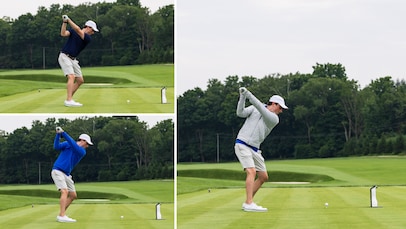 Golf Digest Logo Do layers of clothing slow down swing speed? Our test reveals surprising results
Golf Digest Logo Do layers of clothing slow down swing speed? Our test reveals surprising results
This article was originally published on golfdigest.com




